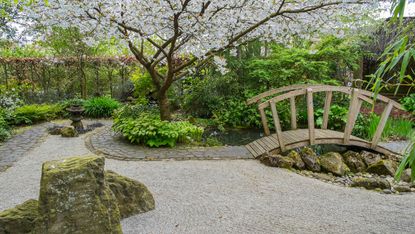
It’s no surprise that Zen garden ideas are so popular. They’re gorgeous, they’re simple, and they’re low-maintenance. Plus, as far as garden designs go, they’re a surefire way to make your outdoor space feel calm. And isn’t that something we all want, to some degree?
Originating from Japan many hundreds of years ago, Zen gardens were traditionally created as places for monks to reflect on the Buddha’s teachings. To encourage contemplation and feelings of peace, they were designed to be minimal spaces, devoid of distractions.
Billowing borders in eye-catching colors may be the stalwarts of other garden design ideas, but Zen gardens follow a more simplistic approach. Often, carefully positioned rocks and pebbles are the stars of the show in these peaceful Japanese garden ideas. Planting is kept to a minimum, or at least to a minimal palette. The result doesn’t just feel quiet and calm, but it looks effortlessly sophisticated, too.
They are ‘a place of meditation, of single elements chosen with care,’ says Lara Gochin Raffaelli, Garden Designer of Enchanted Gardens(opens in new tab). ‘There is no sense of the rampant, of lack of discipline, of profusion. It is a place where you can sit and observe a blossom, a branch, the shape of a rock, or the curves of circles in sand for hours,’ she adds.
The best thing is that Zen garden ideas can be achieved in the smallest of spaces. Even if you’ve only got a tiny courtyard or patio to play with, you can recreate the look. So, if you’re ready to discover how to make your own backyard an oasis of calm, keep scrolling. These ideas are sure to have you inspired.
1. CREATE A STEPPING STONE PATHWAY

A curving path of stepping stones encourages a mindful wander through this plot
(Image credit: John Lander/Alamy Stock Photo/Alamy)

Every garden needs a path or two to get from the lawn to shed, or from the house to the gate. But pathways don’t always have to be purely practical. When weaved around a small tree, a statue, or a body of water, they can also be used to encourage mindfulness.
Bring in some of our favorite stepping stone ideas and the effect is elevated further, as each step requires focus, and pace is automatically slowed. Opt for natural stone and keep lines curved, just like in this serene scene above. The result will allow you to journey around your plot in peace, taking in the surrounding nature and basking in the greenery of nearby foliage.
2. SURROUND A SIMPLE WATER FEATURE WITH PEBBLES
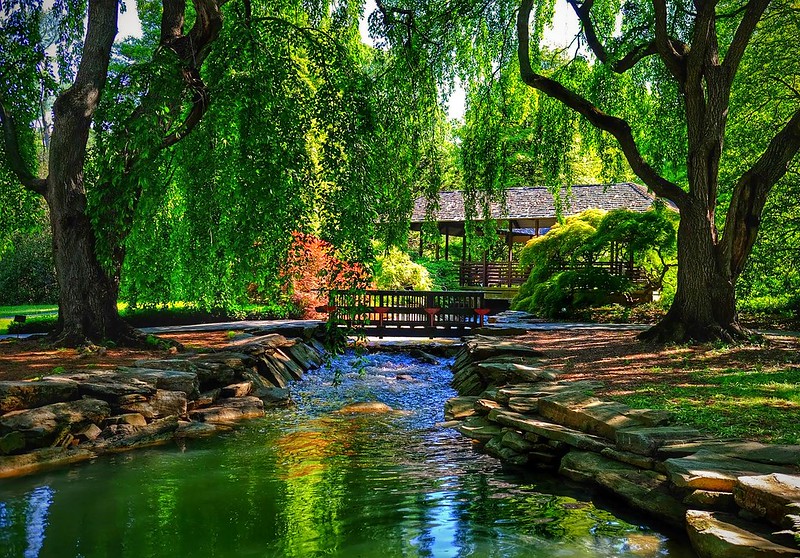
A gently babbling water feature can add to the relaxing tone of a Zen garden
(Image credit: Amateur Gardening/Future)
The sound and sight of water is automatically soothing, which is why water feature ideas are a great addition to Zen gardens. However, don’t be tempted by elaborate designs surrounded by vibrant pond plants. Instead, go simple, like this stunning stone design above.
Surrounded by smooth pebbles and then bordered in fine gravel, this sandy-hued style complements the landscape well. The babbling fountain provides a focal point which can be used to aid meditation, whilst offering a gentle soundscape. Be sure to position somewhere to sit nearby to take in the view.
Try adding a small acer or two nearby, too. It will bring a touch of color to the scene, whilst its gentle sway in the breeze will enhance the feelings of Zen.
3. ADD AN ENCHANTING BRIDGE

A bridge makes a beautiful feature, especially when placed beneath a stunning blossom tree
(Image credit: Digital-Fotofusion Gallery/Alamy Stock Photo/Alamy)
Bridges are a well-known addition to Japanese-style gardens, and work well in Zen gardens too. This isn’t just because of their aesthetic value – bridges can also represent a journey of transition and encourage feelings of reflection.
If you have a pond or even a small stream, a simple wooden structure like the one above is a lovely architectural feature. However, you don’t have to have water to justify a bridge – symbolic features are commonplace in Zen gardens, so finely raked gravel, dry sand, or a pool of pebbles can be used to represent the flow of water instead. ‘These are known as dry rivers,’ says Garden Designer Lara Gochin Raffaelli of Enchanted Gardens. ‘The placement of the dry river is important – it must be arranged to run from east to south to west, as this is the traditional Japanese positioning,’ she adds.
A blossom tree is always a welcome addition to any garden, but works especially well in plots that are Japanese-inspired. As Lara says, ‘…a tree like a flowering cherry (Prunus) would be perfect for contemplating each of the four seasons: the stark, bare branches in winter; the beautiful blossoms in spring; the fresh green (or purple or burgundy or bronze) leaves in summer, and finally, the splendor of orange autumn leaves.’
Take a look at our guide on the best flowering trees for some of our favorite picks.
4. USE LARGE STRETCHES OF GRAVEL
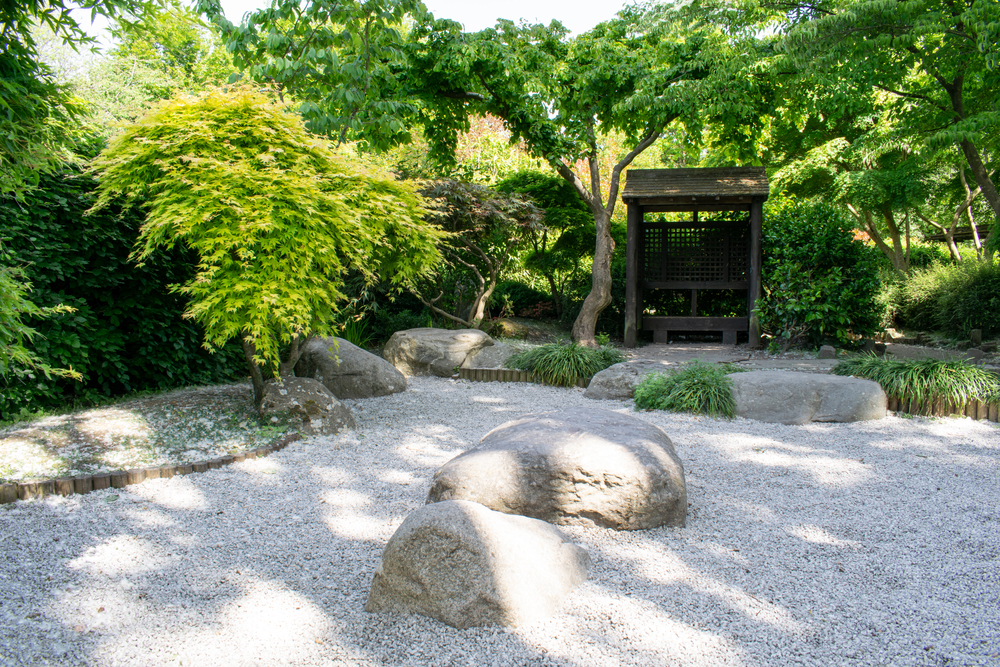
Fine gravel raked into patterns is a key feature of Zen gardens
Fine gravel or sand is one of the most common features of Zen garden ideas, often selected in pale hues. It is known to symbolize water, and can be carefully raked into patterns to create ‘waves’. Not only is the sight soothing, but the process of creating the patterns can be a meditative exercise in itself, as says Garden Designer Lara Gochin Raffaelli.
To recreate the authentic look, add a dedicated gravel area to your plot, perhaps with a border of larger rocks. A central tree, such as this impressive acer, can make a striking focal point and is a means to get creative with patterns. For instance, try a circular pattern around a tree’s trunk, whilst the rest of the area can be raked into orderly straight lines for a gentle contrast.
Looking for more ideas? Head over to our small rock garden ideas.
5. CHOOSE DIFFERENT SHADES OF STONE
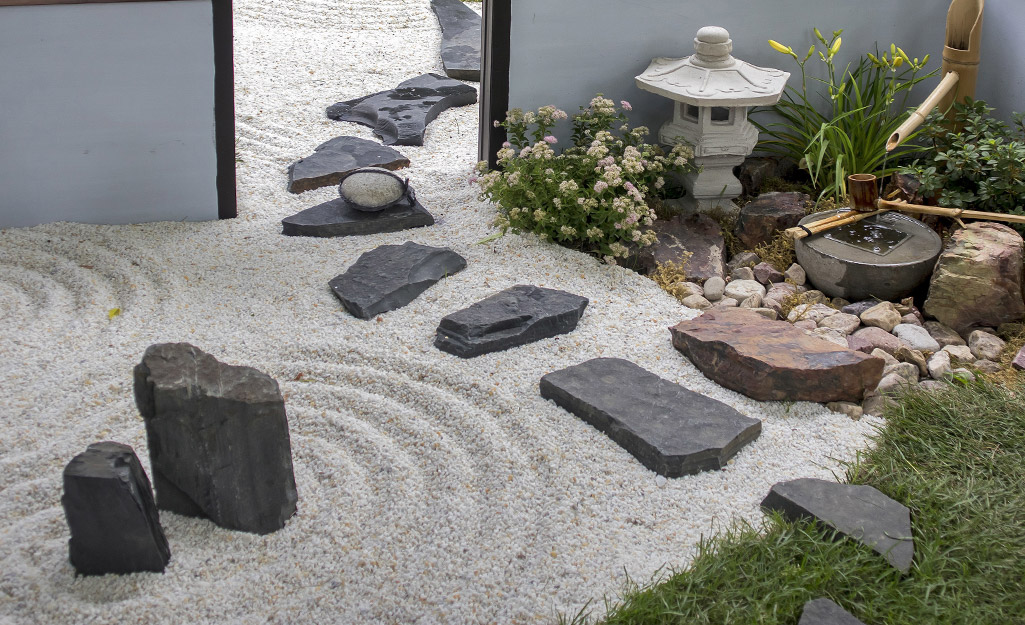
Two tones of gravel are used to create striking shapes in this garden
Everyone knows that getting out into nature is one of the most soothing things you can do, so it’s no surprise that Zen gardens take inspiration from the natural landscape. As mentioned, this often crosses into the realms of symbolism, with features like rocks and moss representing larger parts of the natural world, such as mountains, islands, or forests.
So, as part of your Zen garden ideas, try positioning large stones and rocks as focal features in your plot. They will provide a sculptural element in a naturalistic way.
To take things one step further, opt for two tones of gravel and get creative with shapes. This example above could be interpreted as mountains jutting through clouds, or islands out at sea, but either way the result is spectacular. To keep things in place, surround your shapes with stone edging – our garden edging ideas feature is full of stunning styles.
6. CURATE SMALL POCKETS OF INTEREST

Recreate aspects of the natural world using rocks, pebbles, and greenery
(Image credit: Aron Jungermann/Getty Images)
Another more simple way to create pockets of interest for your Zen garden ideas is to arrange miniature rockeries alongside your path, lawn, or gravelled space. Pick complementary tones and add a mixture of textures for visual appeal that mirrors the natural environment.
Ornamental grass can provide welcome height and break up the stretch of stone – learn how to grow ornamental grasses with our guide. Marcus Eyles, Horticultural Director of Dobbies Garden Centres(opens in new tab) suggests to try larger foliage types such as miscanthus and pampas grasses (cortaderia), or the blue Festuca glauca for ground cover. Try Japanese forest grass for shaded areas.
7. OPT FOR AN ARCHWAY

This Japanese-inspired garden, designed by Rhoda Maw Garden Design(opens in new tab), is bound to turn heads
(Image credit: Rhoda Maw Garden Design)
If you’re looking to add extra height and interest to your Zen garden ideas, then how about taking inspiration from this space, designed by Rhoda Maw Garden Design(opens in new tab)? The Corten steel moon gate creates an enticing feature as it arches over a path, yet is elegantly pared-back.
It’s a lovely way to frame plants or other focal points in the garden, and works especially well for narrow plots when combined with a stepping stone path.
Take a look at our garden path ideas for more stunning designs.
8. PLANT FERNS AMONGST YOUR ROCKS
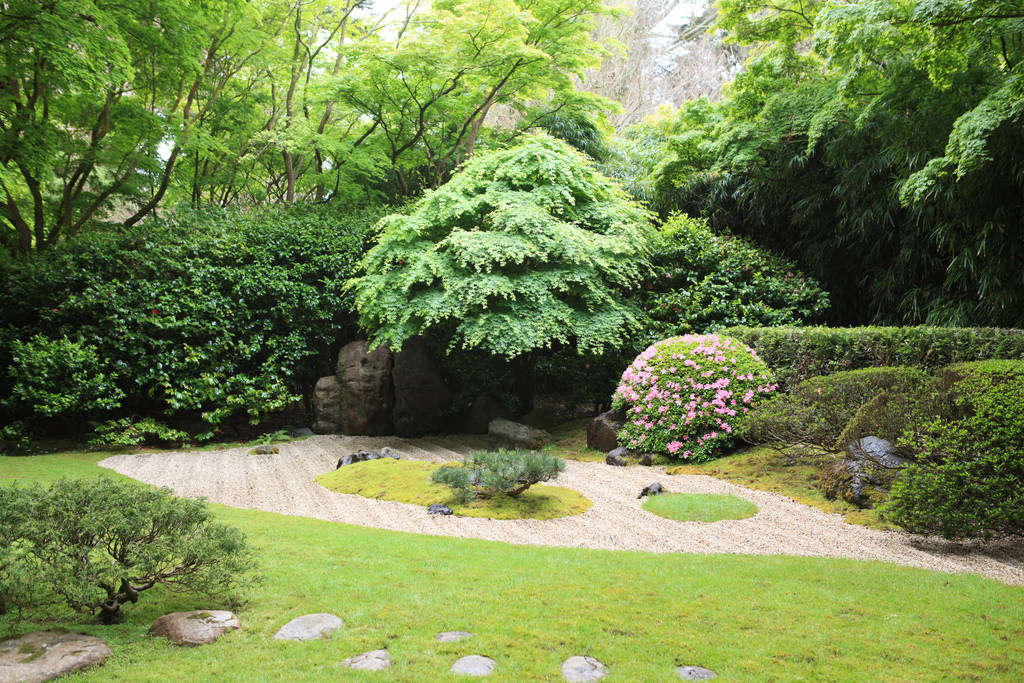
Ferns add a soothing dose of green to a garden and evoke a woodland-like ambience
(Image credit: B.S.P.I./Corbis Documentary/Getty Images)
If you want to give your Zen garden ideas an old-world vibe, then learning how to grow ferns is a good place to start. They’re a lovely way to soften hard textures and create a cooling, woodland feel. Marcus Eyles, Horticultural Director of Dobbies Garden Centres suggests opting for hardy evergreen types – including slow-growing tree ferns, hart’s-tongue fern (Asplenium scolopendrium) and wood fern (dryopteris).
Plant amongst stone walls, or at the sides of borders to welcome their vibrant tones of green to your plot. They look especially striking amongst mossy areas – another classic choice for Japanese-inspired spaces.
9. ADD SOOTHING SOUNDS WITH TRADITIONAL FEATURES
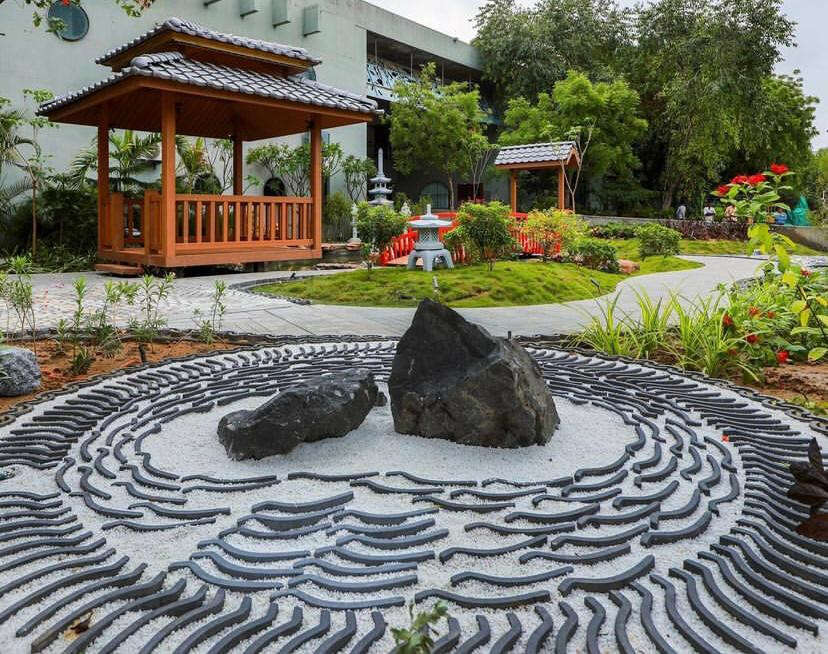
A Shishi Odoshi is a traditional water feature with a soothing sound
(Image credit: Mark Scott/Future)
This water feature above is known as a Shishi Odoshi, which are traditionally seen in Japanese gardens. Made from bamboo, they create a soothing, periodic noise which, although originally meant to deter deer, can be rather appealing.
They make a good addition to Zen garden ideas, especially when surrounded by an array of flat stones and rocks, as seen here. For more peaceful accents to your plot, take a look at our sensory garden ideas.
10. GO FOR CURVED EDGES FOR YOUR ZEN GARDEN IDEAS

Clip your evergreens into soft, curved shapes
(Image credit: Caroline De Vries/Getty Images)
Zen garden ideas benefit from soothing shapes, so when thinking about the landscaping of your plot, welcome in curves. This can be from your lawn and paths to the lines raked in your gravel, but also consider trying your hand at topiary.
Evergreen azaleas and other shrubs (and even trees) can be clipped into soft, round, cloud-like shapes, for a soothing scene. This is a traditional approach in many Japanese gardens, and is known as Niwaki. It’s not too tricky to recreate either, all you need is your best garden shears and a bit of practice.
Take a look at our small Japanese garden ideas for more inspiration.
11. BRING COLOR TO THE SCENE WITH ACERS
Bright red acer trees will always steal the show come autumn
(Image credit: Masako Ishida/Moment Unreleased/Getty Images)
Although Zen garden ideas tend to stick to simple palettes of natural stones and green foliage, a well-considered pop of color here and there can add a pleasing touch. This is especially the case when it comes from the Japanese garden staple – an acer tree.
Available in tons of varieties and sizes, these leafy beauties sport show-stopping tones in autumn, such as this fiery red. Paired against minimal backdrops and stark rock formations, they can look spectacular.
Learn how to grow acers for year-round interest in your garden with our guide.
WHAT ARE THE BEST PLANTS FOR ZEN GARDENS?
Tucked-away stairs amongst neatly-shaped shrubs add a sense of intrigue to this scene
(Image credit: Krzysztof Baranowski/Moment Open/Getty Images)
Lara Gochin Raffaelli, Garden Designer from Enchanted Gardens, shares her suggestions for the best plants for Zen gardens.
Choose some plants that are evergreen for year-round interest and structure, she says. Think bamboo (make sure to select the non-invasive type), conifers, Liriope muscari, Pachysandra terminalis, grasses, or even semi-evergreen ferns.
Lara also recommends to pick plants which will provide interest in different seasons. For instance, Prunus ‘Kanzan’ will provide pretty pink blossoms in spring, but also striking yellow-orange foliage in autumn. Acer palmatum is another choice for autumn interest, with its red-orange leaves. White hydrangeas make a stunning accent throughout the summer months – our guide on how to grow hydrangeas is full of useful tips.
Characterized by rock formations that mimic water and other natural features, karesansui (dry landscape) is the epitome of a Japanese garden. These stone gardens, also known as Zen gardens outside Japan, have a rich history dating back to the 12th century.
However, today’s stone gardens aren’t just static copies of traditional landscape architecture, but rather a constantly evolving expression of Zen thought, found everywhere from ancient temple grounds to modern yards. Learn more about the origins of these tranquil, thought-provoking gardens and inspire your customers who want to have their own.
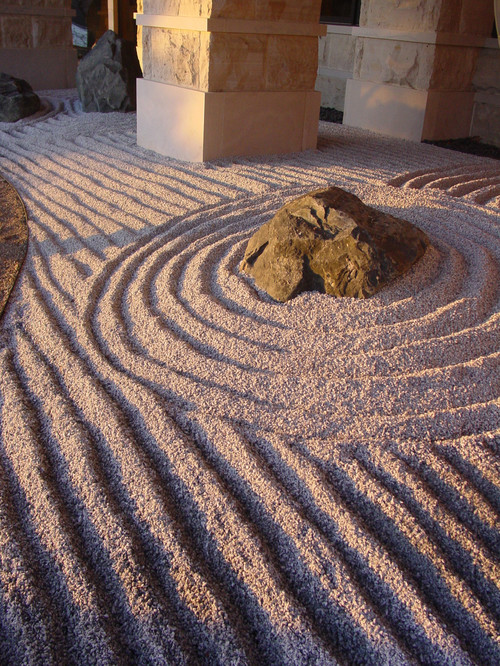
Origins of stone gardens
The oldest known description of stone gardens is found in the Sakuteiki, or Records of Garden Making, written in the late Heian period (11th century). It reads, “A garden of arranged stones that has neither a pond nor a stream shall be called a dry landscape garden, one that expresses a water-filled natural landscape without the actual presence of water.”
We don’t know exactly what this kind of garden looked like, since the ones from the period no longer exist. However, later Japanese gardening practices were heavily influenced by Zen philosophy, which was not yet widespread in Japan when the Sakuteiki was written. So the gardens it describes may have been somewhat different from their later incarnations. Still, it’s clear that the key feature of a stone garden — evoking water in a dry landscape — existed. Two factors influenced their evolution into their modern forms.

1. Zen teachings. The first factor was the spread of Zen thought throughout Japan. This school of Buddhism came from China and flourished in Japan from the Kamakura period to the Edo period (late 12th century to early 16th century).
The first full-fledged stone garden was created in Kyoto’s Saihoji Zen temple by Muso Soseki (1275-1351), whose work holds an important place in the history of Japanese gardening. The gardener-monk was summoned to reconstruct the nearly forsaken Saihoji — formerly dedicated to another school of Buddhism, Pure Land Buddhism — as a Zen temple. The reconstruction entailed numerous changes, including modifications to the garden. He decided to create a stone garden as a place for monks to practice Zen. Rocks hold a special place in Zen thought as expressions of the force of nature, and one practice involves the contemplation of rocks as a way of becoming aware of that which is invisible.
2. Art forms. The second factor that led to the development of the modern-day stone garden was the influence of the bonkei and sansuiga art forms. Bonkei (tray scenery) is the practice of arranging sand, stones and miniature plants on a tray to create a miniature replica of natural scenery; it is from bonkei that the famous Japanese bonsai tradition evolved. Such trays were displayed at celebrations as decoration for the interior of a house. Sansuiga is a style of landscape painting that was popular among Zen priests. Both art forms influenced the aesthetics and composition of stone gardens.
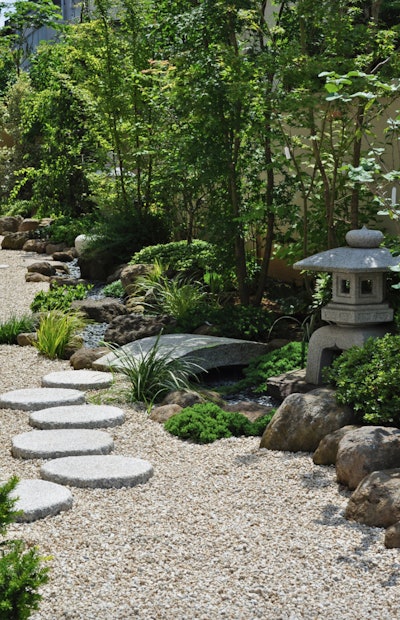
Further evolution
These two factors led to the development of the current type of stone garden. This new form also fit well with the advent of the wabi-sabi aesthetic, or the appreciation of that which is imperfect or incomplete. Stone gardens, therefore, began to be adopted beyond Zen temples as even samurai and merchants began creating their own. However, in the middle of the Edo period (1603–1867), naturalistic gardens that favored living plants stole the spotlight for a time.
Stone gardens experienced a resurgence in the Showa period (20th century), when gardener-historian Mirei Shigemori (1896-1975) created over 200 timeless examples. Despite holding to the traditional rules of stone arrangement, his gardens weren’t blind imitations of the old ways. Instead, he combined his own innovations and modern aesthetics with traditional forms.
Symbolism
Stone gardens are rich in symbolism, many reflecting Zen and ancient Chinese philosophies. It’s necessary to understand this layer of meaning to fully appreciate these gardens as more than just a collection of rocks.
For example, many gardens include the horai-jima, a representation of the unreachable island of immortals of Chinese legend. Smaller tsuru-jima (crane islands) and kame-jima (turtle islands), which symbolize longevity, are often built in its immediate proximity (not pictured).
Small stones that represent treasure ships, themselves symbolic of luck and prosperity, are usually arranged to a point with one of their ends toward the island of immortals, and are often seen in such gardens as well. They are either heading for the island to claim its treasures or heading home with their spoils. Their load is indicated by their height above the sand waves.
Ryumon-baku, named for the legendary Ryumon (Dragon Gate) waterfall on China’s Yellow River, is a known Zen symbol. According to the legend, any carp that managed to climb the waterfall would immediately turn into a dragon and soar into the sky. This is also the origin of the iconic Japanese koinobori (carp streamers). Zen teachings use this story to explain the attitude a practitioner needs to have to achieve enlightenment.
In the next photo, the sand represents the Yellow River, the ripples represent the waterfall, and the rock that juts out represents the carp. This symbolism is incorporated in the Saihoji garden as well; there, the rocks serve as a place for seated Zen meditation.
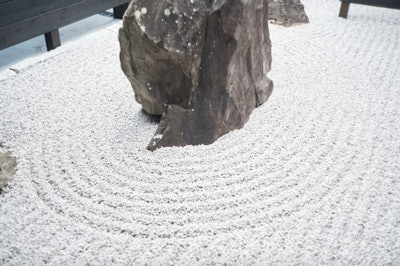
Water patterns
A rippling pattern in the sand that represents waves is called samon. This stems from the tradition during the Heian era (794–1192) of covering sacred spaces with white sand. Under the influence of bonkei, this sand came to be arranged in the form of waves to symbolize water.
Various patterns of ripples are used to symbolize river or ocean waters. Even in the same ocean you may encounter both big waves and mere ripples on the water’s surface. Although the large stones are usually more eye-catching, you can entertain yourself by contemplating the sand patterns and trying to guess what kind of waters they represent.
The patterns are usually drawn by a local priest using a rake or a broom. It is said that Muso Soseki wouldn’t leave even a speck of dust in his own garden. He believed that the habit of sweeping a garden serves to cleanse the mind of worldly thoughts. Likewise, drawing ripples in the sand is useful for calming and purifying the mind.
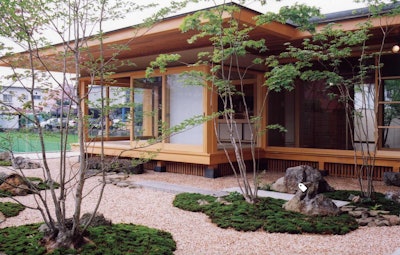
Stone gardens and modern households
Stone gardens have experienced a boom in popularity outside Japan. They are less popular within the country, though in recent years, even the younger generations are turning their attention back toward Japanese traditional culture.
As long as you don’t think too big, making a stone garden isn’t an impossible task. Why not create a pleasant place where your client can take a moment to rest from their busy life and calm their soul? Don’t worry about breaking any rules: These gardens are meant to change with the flow of time and don’t have to be copies of historic gardens. Their cultural legacy is in creating something that touches a contemporary viewer’s soul, rather than just blindly imitating the past.
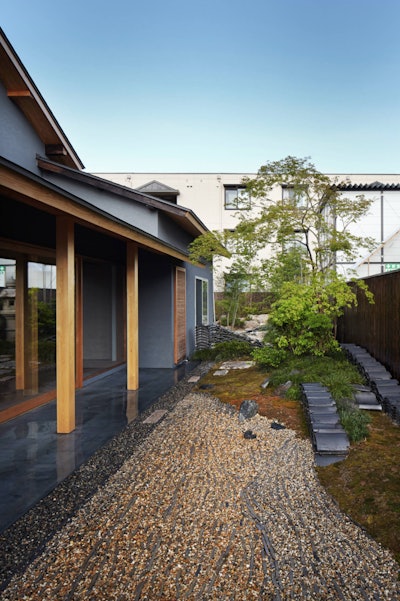
Although this garden boasts no grand stonework, it incorporates sand ripples, which are a major part of stone garden culture. The pattern is expressed by tiles laid in the sand and is easy to maintain because it doesn’t need to be drawn manually.
Instead of stones, a slight slope adds volume to the garden and expresses a view of nature. Planting trees in a pattern that reflects how they might grow in a forest makes the garden look perfectly natural.
It’s possible to create grand-looking scenery even in a confined space by using only small lanterns and stones. Features where stones represent ponds are called kareike (dry ponds). One of their advantages is that they’re easier to create and maintain than ponds with real water.

Adding waterside plants, such as sweet flag, makes the illusion even more convincing.
Free of ostentation, stone gardens beam with an irresistible charm. Gardens that have been used for centuries for practicing Zen may be just what we need today to remind us to take a moment from our busy lives to reflect on ourselves.